Peer-Reviewed by Plant Health Progress
Accepted for publication 3 May 2002. © 2002 Plant Management Network.
Brian B. McSpadden Gardener, Department of Plant Pathology, The Ohio State University-OARDC, Wooster, OH 44691; and Deborah R. Fravel, Vegetable Laboratory, USDA, ARS, Beltsville, MD 20705
Corresponding author: Brian B. McSpadden Gardener. bbmg+@osu.edu
McSpadden Gardener, B. B., and Fravel, D. R. 2002. Biological control of plant pathogens: Research, commercialization, and application in the USA. Online. Plant Health Progress doi:10.1094/PHP-2002-0510-01-RV.
Biological control of plant pests and pathogens continues to inspire research and development in many fields. Plant pathogens are just one class of targets of biological control, which also is designed to limit other pests such as insects, parasitic nematodes, and weeds. In the narrowest sense, biocontrol involves suppressing pest organisms with other organisms. However, the interrelationships of many environmental variables can result in multiple interactions among organisms and their environment, several of which might contribute to effective biological control. Furthermore, natural products and chemical compounds discovered as a result of basic research into the molecular mechanisms of pathogenesis and biological control have led to the development of “biorational” pesticides. Here, we use the term biological control in the broader sense as we describe the current status of research, commercial development, and application of biocontrol strategies targeted at plant pathogens. We conclude by describing future prospects for using biological control to limit the damage of plant pathogens in both conventional and organic agriculture.
Research
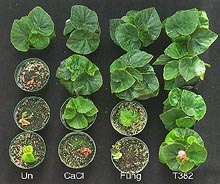
Fig. 1. Example bioassay for biological control of a plant pathogen. Begonias were grown in the greenhouse and inoculated with Botrytis cinerea under conditions optimal for the development of disease. Treatments differing in their efficacy are shown, from left to right: untreated (Un), CaCl2, chlorothalonil (Fung), and the biocontrol agent Trichoderma hamatum T382 inoculated into the potting mix (T382). Photo courtesy of Dr. H. Hoitink. (Click image for larger view.) |
|
Over the past one hundred years, research has repeatedly demonstrated that phylogenetically diverse microorganisms can act as natural antagonists of various plant pathogens (6) (Fig. 1). The interactions between microorganisms and plant hosts can be complex. Interactions that lead to biocontrol can include antibiosis, competition, induction of host resistance, and predation (7). When testing bacterial and fungal isolates from the environment for biocontrol activities, between 1 and 10% show at least some capacity to inhibit the growth of pathogens in vitro. However, fewer isolates can suppress plant diseases under diverse growing conditions and fewer still have broad-spectrum activity against multiple pathogenic taxa. Nonetheless, intensive screens have yielded numerous candidate organisms for commercial development. Some of the microbial taxa that have been successfully commercialized and are currently marketed as EPA-registered biopesticides in the United States include bacteria belonging to the genera Agrobacterium, Bacillus, Pseudomonas, and Streptomyces and fungi belonging to the genera Ampelomyces, Candida, Coniothyrium, and Trichoderma (20). Screening is a critical step in the development of biocontrol agents. The success of all subsequent stages depends on the ability of a screening procedure to identify an appropriate candidate. Many useful bacterial biocontrol agents have been found by observing zones of inhibition in Petri plates (Fig. 2). However, this method does not identify biocontrol agents with other modes of action such as parasitism, induced plant resistance, or some forms of competition. Screening methods for parasitism include burying and retrieving propagules of the pathogen to isolate parasites. For competition, methods include looking for microbes that quickly colonize sterilized soil and have the ability to exclude other organisms that attempt to invade the space, and looking for microbes that colonize the infection court. Primary screens for new biocontrol microbes are still undertaken (13), and it seems likely that continued prospecting will be required to diversify the potential applications of biocontrol as well as replace more widely used biocontrol products should resistance develop.
|
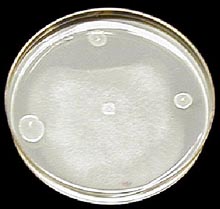
Fig. 2. Example in vitro inhibition assay. Different bacterial isolates are tested for their ability to inhibit the growth of Pythium spp. SF2, a soilborne plant pathogen that can cause damping-off of corn and soybean seedlings. Zones of growth inhibition can be detected around strains placed at two of the four positions on the plate (click image for larger view). |
|
In addition, other areas of research in the field of plant pathology have opened up new opportunities for disease control. Research on the mechanisms of biocontrol employed by effective bacterial strains has revealed a variety of natural products that can be exploited for the development of chemical control measures. One well-known example is pyrrolnitrin, a natural product produced by some Pseudomonas spp. That compound provided the chemical model for development of fludioxonil, a broad-spectrum fungicide used as seed treatment, foliar spray, or soil drench (14). Research into the mechanism by which plants resist bacterial pathogens (10) led to the discovery of harpin, a protein that is now being used to activate crop defenses prior to pathogen attack. Indeed, a variety of pathogenic and non-pathogenic microorganisms can induce plant defenses and may be useful as biocontrol agents (22). Other research, on the effects of organic amendments, suggests that both chemical and biological components of compost-amended soils can contribute to disease suppression (1,5,24). Such discoveries point to the substantial potential of diverse programs in basic research to lead to improvements in various biological control strategies.
A variety of research questions remain to be fully answered about the nature of biological control and the means to most effectively manage it under production conditions. Advanced molecular techniques are now being used to characterize the diversity, abundance, and activities of microbes that live in and around plants, including those that significantly impact plant health (15,17). Still, much remains to be learned about the microbial ecology of both plant pathogens and their microbial antagonists in different agricultural systems (12,23). Fundamental work remains to be done on characterizing the different mechanisms by which organic amendments reduce plant disease (9). More studies on the practical aspects of mass-production and formulation need to be undertaken to make new biocontrol products stable, effective, safer and more cost-effective (8).
Commercial development*
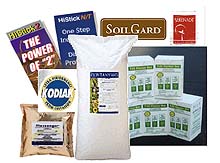
Fig. 3. Composite picture of several products currently being sold as biopesticides for the control of plant diseases (click image for larger view). |
|
Interest in biological control research continues reflecting the desire of multiple constituencies to develop sustainable methods for controlling plant disease. Growing concerns about environmental health and safety have led to substantial regulatory changes in the past several years, including the Food Quality Protection Act of 1996 (Appendix 1). The FQPA reconciles previous discrepancies between pesticide regulation under the Federal Insecticide, Fungicide, and Rodenticide Act (FIFRA) and the Federal Food Drug, and Cosmetic Act (FFDCA). Such concerns have led to increased restrictions on a variety of chemical pesticides, including some of those used to suppress plant diseases. The IR4 program also encourages the development of biorational pesticides (Appendix 1). The CREES Biological Control Working Group (Appendix 1), which brings together representatives of state and federal agencies and the private sector, have published a white paper defining a new paradigm for biocontrol and outlining action steps to foster further development of the industry (4). In addition, the majority of growers continue to express interest in biologically-based pest management strategies of all types as central components of an IPM approach. Such market realities promote the development of biocontrol products. Still, the path to developing and applying effective biocontrol methods is a long one, fraught with a variety of difficulties (16). Scientific, regulatory, business management, and marketing issues must all be handled effectively for a biocontrol product to be successful in the marketplace.
Currently in the US, a number of biologically-based products are being sold for the control of plant diseases (Fig. 3, Appendix 2). A growing number of companies are also developing new products that are in the process of being registered. Many of these companies are small, privately owned firms with a limited product-line (e.g., Galltrol produced by AgBiochem). Others are publicly traded and have substantial capitalization values of between 10 and 100 million dollars (e.g., Eden Bioscience). In addition, larger, billion-dollar companies with more diverse product lines that include a variety of agricultural chemicals and biotechnologies (e.g., Gufstafson LLC, Monsanto, Syngenta) have played a significant role in the development and marketing of products for the control of plant pathogens. Because the cost of registering a product with the EPA as a biopesticide can be between $200,000 and $500,000, a minimum capitalization close to 1 million dollars is required for establishing a start-up company. The time to complete registration currently averages under 18 months, but the data generation requirements for different types of products and the level of experience a company has with past registrations can significantly impact the time to registration. To assist companies with the registration process, the EPA sponsors workshops each year. Biocontrol products are either marketed as stand-alone products or formulated as mixtures with other microbials (e.g., High Stick N/T) or synthetic fungicides (e.g., Kodiak). Some products with biocontrol properties may not be registered, but are sold instead as plant strengtheners or growth promoters without any specific claims regarding disease control. To help improve the global market perception of biopesticides as effective products, the Biopesticide Industry Alliance is establishing a certification process to ensure industry standards for efficacy, quality, and consistency (P. Marrone, personal communication).
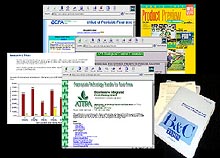
Fig. 4. Composite picture of web pages, product literature, and scientific journals. All contain information on biological control agents for use in controlling plant diseases (click image for larger view). |
|
More complete information on commercially available biocontrol products can be obtained from a number of sources (Fig. 4). The U.S. Environmental Protection Agency's Office of Pesticide Programs manages a website containing substantial amount of information on biopesticides (Appendix 1). In addition, listings of products and sources can be freely obtained from sites managed by ATTRA and the APS Biological Control Committee (Appendix 1). Several companies also have had the Organic Materials Review Institute (OMRI) certify their products as suitable for organic production (Appendix 1). Product labels and material safety data sheets for biopesticides as well as many other pesticides can be freely obtained from CDMS, a private information service (Appendix 1). Additional contact information can be obtained from a variety of business information sources for a fee (e.g., CPL Scientific Information Co, or Harris InfoSource [Appendix 1]). Efficacy data are generally available from the producers of biopesticides, most of whom who have invested substantial sums of money into the development and testing of their products. Independent assessments of efficacy can be found scattered in a variety of sources, including extension reports and bulletins as well-as scientific journals published by the American Phytopathological Society including Plant Disease and Biological and Cultural Tests (Appendix 1) which are available in print and on-line formats.
*Mention of trade names or commercial products in this publication is solely for the purpose of providing scientific information. Mention within this article does not imply recommendation or endorsement by the Ohio State University or U. S. Department of Agriculture of said products, nor does it reflect prejudice against other commercial products or ventures that are not described.
Application
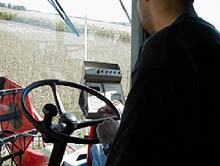
Fig. 5. Electronic monitoring of yield and moisture at harvest (click image for larger view).
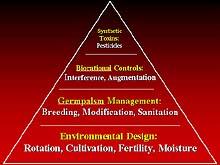
Fig. 6. General model for an integrated pest management (IPM) program (click image for larger view).
|
|
Successful application of biological controls requires more knowledge-intensive management (4) (Fig. 5). To this end, extension personnel and growers must also become more fully aware of the costs and benefits that biopesticides can provide. Understanding when and where biological control of plant pathogens can be profitable requires an appreciation of its place within integrated pest management systems (11). For this purpose, the model of a pyramid can be used to highlight the way growers might productively construct their pest management programs (Fig. 6).
In this model, the foundation of a sound pest and disease management program in an annual cropping system begins with sound cultural practices that alter the farm landscape to promote crop health. These include crop rotations that limit the availability of host material used by plant pathogens. Judicious use of tillage can disrupt pest and pathogen life cycles, bury weeds, and prepare seed beds of optimal moisture and bulk density. Careful management of soil fertility and moisture can also limit plant disease by minimizing plant stress. In nurseries and greenhouses, environmental control can be more tightly regulated in terms of temperature, light, moisture, and soil composition (i.e., peat-based potting mixes), but the design of such systems cannot wholly eliminate pest problems.
The second layer of defense against pests consists of the quality of crop germplasm. Breeding for pathogen resistance contributes substantially to crop success in most regions. Newer technologies that directly incorporate genes into crop genomes, commonly referred to as genetic modification or genetic engineering, are bringing new traits into crop germplasm. The most-widely distributed of these plant-incorporated protectants (PIPs) are the different insecticidal proteins derived from Bacillus thuringiensis. Other technologies, such as seed washing, testing for pathogens, and treatment are also used to keep germplasm pathogen-free. In perennial cropping systems, such as orchards and forests, germplasm quality may be more important than cultural practices, because rotation and tillage cannot be used as regularly. Upon these two layers, growers can further reduce pest and pathogen pressure by considering both biological and chemical inputs.
Biologically-based inputs such as pheromone traps and microbial pesticides can be used to interfere with pest activities. Registered biopesticides are generally labeled with short reentry intervals (REI) and pre-harvest intervals (PHI), giving greater flexibility to growers who need to balance their operational requirements and pest management goals. When living organisms are introduced, they may also augment natural beneficial populations to further reduce the damage caused by targeted pathogens or pests.
Finally, synthetic chemicals may be added to limit crop damage by pests and pathogens. Because of growing concerns about health and environmental safety, the use of toxic, carcinogenic, and/or environmentally damaging chemicals is currently being discouraged. Within the context of IPM programs, the use of such chemicals should be considered only after other management options have been fully implemented.
Clearly, the different levels described by this model are not entirely independent of one another. Indeed, the numerous biotic and abiotic variables that influence crop health are rarely independent of one another. Such complexities point to the need for more integrative, multidisciplinary research on agricultural systems that will provide a deeper understanding of the conditions under which microbial biocontrol agents might be most productively applied.
The goals of an IPM program are simple: minimize the economic and environmental costs of controlling plant pests and achieve sustainable agricultural production. All disease management strategies have associated costs. Growers need to carefully assess the potential costs and benefits of different disease management strategies. Conventional growers may have more options available to them in terms of chemical alternatives, but economic pressures to limit rotations or reduce tillage may promote more serious disease problems. In contrast, certified organic farmers are prevented from using most pesticides, including those commonly used as seed treatments, but longer and more diverse rotations may limit disease problems. In both cases though, thorough disease assessments are needed to determine the amount of disease pressure present and the causal agents. If the severity of a particular disease problem justifies management action beyond the first two tiers of the IPM model described above (Fig. 6), then on-site testing of biocontrol products can generally be recommended. Because research has shown that the efficacy of microbial biocontrols can vary somewhat from site to site and year to year (e.g., 2,3), trials should include the use of side-by-side comparisons with untreated controls and adequate replication (n  3) across the farm over multiple growing seasons.
3) across the farm over multiple growing seasons.
Future Prospects
There is a growing demand for sound, biologically-based pest management practices. Recent surveys of both conventional and organic growers indicate an interest in using biocontrol products (19,21), suggesting that the market potential of biocontrol products will increase in coming years. Applications of diverse biological control strategies have been successful in the greenhouse industry (where environmental design and control is greatest) and continue to increase (18). Funding for basic and applied research continues to be provided by the USDA's Cooperative Research, Education, and Extension Service through a variety of programs (e.g., the National Research Initiative [NRI], and the Pest Management Alternatives Program [PMAP]) as well as internally within the Agricultural Research Service (Appendix 1). Such investment will ensure that innovations in biological control research will continue. An upswing in commercial interests has also developed in the past few years, and prospects for increased growth are positive. The Biopesticide Industry Alliance has formed and it is now actively promoting the value and efficacy of biopesticides (including those that control plant pathogens). Clearly, the future success of the biological control industry will depend on innovative business management, product marketing, extension education, and research (4,16). Increased demand for organic produce and participation in home gardening activities by pesticide-wary urban populations has enlarged the market for biocontrol products. The field of plant pathology will contribute substantially to making the 21st century the age of biotechnology by the development of innovative biocontrol strategies.
Literature Cited
1. Abbasi, P. A., Al-Dahmani, J., Sahin, F. Hoitink, H. A. J., and Miller, S. A. 2002. Effect of compost amendments on disease severity and yield of tomato in conventional and organic production systems. Plant Dis. 86:156-161.
2. Batson, W., Caceres, J., Benson, M., Cubeta, M., Brannen, P., Kenny, D., Elliott, M., Huber, D., Hickman, M., Keinath, A., Dubose, V., Ownley, B., Newman, M., Rothrock, C., Schneider, R., and Summer, D. 2000. Evaluation of biological seed treatments for control of the seedling disease complex of cotton. Biol. and Cult. Tests 15:31-32.
3. Batson, W., Caceres, J., Benson, M., Cubeta, M., Brannen, P., Kenny, D., Elliott, M., Huber, D., Hickman, M., Keinath, A., Dubose, V., Ownley, B., Newman, M., Rothrock, C., Schneider, R., and Summer, D. 1999. Biological seed treatments for control of the seedling disease complex of cotton. Biological and Cultural Tests 14:25-26.
4. Biological Control Working Group. 1998. Alternative paradigms for commercializing biological control: Workshop whitepaper. Online. Rutgers Workshop Organizing Committee and Experimental Station Committee on Policy.
5. Bulluck, L. R. III, and Ristaino, J. B. 2002. Effect of synthetic and organic fertility amendments on southern blight, soil microbial communities, and yield of processing tomatoes. Phytopathology 92:181-189.
6. Cook, R. J. 2000. Advances in plant health management in the 20th century. Ann. Rev. Phytopathol. 38:95-116.
7. Cook R. J. and Baker K. F. 1983. The Nature and Practice of Biological Control of Plant Pathogens. American Phytopathological Society, St. Paul, MN.
8. Fravel, D. R., Rhodes, D. J., and Larkin, R. P. 1999. Production and commercialization of biocontrol products. Pages 365-376 in: Integrated Pest and Disease Management in Greenhouse Crops. R. Albajes, M. L. Gullino, J. C. van Lenteren, and Y. Elad, eds. Kluwer Academic Publishers, Dordrecht.
9. Hoitink, H. A. J. and M. J. Boehm. 1999. Biocontrol within the context of soil microbial communities: A substrate dependent phenomenon. Annu. Rev. Phytopathol. 37:427-446.
10. Hutchinson, S. W. 1998. Current concepts of active defense in plants. Annu. Rev. Phytopathol. 36:59-90.
11. Jacobsen, B. 1997. Role of plant pathology in integrated pest management. Annu. Rev. Phytopathol. 35:373-391.
12. Kerry, B.R. 2000. Rhizosphere interactions and the exploitation of microbial agents for the biological control of plant-pathogenic fungi. Ann. Rev. Phytopahtol. 38:423-441.
13. Larkin, R. P. and Fravel, D. R. 1998. Efficacy of various fungal and bacterial biocontrol organisms for control of Fusarium wilt of tomato. Plant Dis. 82: 1022-1029.
14. Ligon, J. M., Hill, D. S., Hammer, P. E., Torkewitz, N. R., Hofmann, D., Kempf, H. J., van Pee, K. H. 2000. Natural products with antifungal activity from Pseudomonas biocontrol bacteria. Pest Man. Sci. 56:688-695
15. Louws, F. J., Rademaker, J. L. W., and de Bruijn, F. J. 1999. The three Ds of PCR-based genomic analysis of phytobacteria: Diversity, detection, and disease diagnosis. Annu. Rev. Phytopathol. 37:81-125.
16. Mathre, D. E., Cook, R. J., and Callan N. W. 1999. From discovery to use: Traversing the world of commercializing biocontrol agents for plant disease control. Plant Dis. 83:972-983.
17. McSpadden Gardener, B., and Weller, D. M. 2001. Changes in populations of rhizosphere bacteria associated with take-all disease of wheat. Appl. Environ. Microbiol. 67:4414-4425.
18. Paulitz, T. C., and Belanger, R. B. 2001. Biological control in greenhouse systems. Ann. Rev. Phytopathol. 39:103-133.
19. Rzewnicki, P. 2000. Ohio organic producers: Final survey results. Online. Ohio State University Extension, College of Food Agricultural and Environmental Sciences. Bulletin, Special Circular 174.
20. United States Environmental Protection Agency. Topics: Biopesticides. Online. Office of Pesticide Programs.
21. Van Arsdall, R. T., and Frantz C. 2001. Potential role of farmer cooperatives in reducing pest risk: Final report. Online. National Council of Farmer Cooperative. US EPA, Pesticide Environmental Stewardship Program.
22. Van Loon, L. C., Bakker, P. A. H. M., and Pietrse, C. M. J. 1998. Systemic resistance induced by rhizosphere bacteria. Ann. Rev. Phytopathol. 36:453-483.
23. Weller, D. M., Raaijmakers, J. M., McSpadden Gardener, B., and Thomashow, L. S. 2002. Microbial populations responsible for specific soil suppressiveness to plant pathogens. Ann. Rev. Phytopathol. In press.
24. Zhang, W., Han, D. Y., Dick, W. A., Davis, K. R., and Hoitink, H. A. J. 1998. Compost and compost water extract-induced systemic acquired resistance in cucumber and Arabidopsis. Phytopathology 88:450-455.
Additional Resources
Agricultural Research Service (USDA-ARS) National Programs.
Appropriate Technology Transfer for Rural Areas (ATTRA): Biointensive IPM, Fundamentals of Sustainable Agriculture.
B&C Tests: Biological and Cultural Tests for Control of Plant Diseases from the American Phytopathological Society.
Biological Control: A Guide to Natural Enemies in North America. From Cornell University.
Biological Control Committee of the American Phytopathological Society.
Biological Control Working Group (BCWG): 1998 Conference on Alternative Pardigms for Commercializing Biological Control.
Biopesticides: From the EPA Office of Pesticide Programs.
Commercial site for agrobiologicals from CPL Scientific Publishing Services (CPL Press).
National Institute of Food and Agriculture (NIFA). From the USDA.
Food Quality Protection Act (FQPA) of 1996: From the EPA.
Interregional Research Program #4 (IR-4 Project).
National Foundation for Integrated Pest Management
Organic Materials Review Institute (OMRI).
Plant Disease: A Journal of the American Phytopathological Society.
Product labels and material safety data sheets for biopesticides from Crop Data Management Systems, Inc. (CDMS).
Appendix 2: Commercially Available Biocontrol Products
Table 1. List of biocontrol products commercially available for the control of plant pathogens within the US. The products listed are all currently registered with the US EPA.
| Bacteria |
| Agrobacterium radiobacter |
Galltrol
Nogall |
| Bacillus spp.: |
Companion
HiStick N/T
Kodiak
Serenade
YieldShield |
| Burkholderia cepacia |
Deny
Intercept |
| Pseudomonas spp. |
BioJect Spot-Less
Bio-save
BlightBan
Cedomon |
| Streptomyces spp. |
Actinovate*
Mycostop |
| Fungi |
| Ampelomyces quisqualis |
AQ10 |
| Candida oleophila |
Aspire |
| Coniothyrium minitans |
Contans WG/Intercept WG |
Myrothecium verrucaria
(killed) |
DiTera |
Trichoderma spp./
Gliocaldium spp. |
Plantshield/Rootshield/T-22 Planter box
Soilgard
Primastop |
| Plant Activators |
| Bacteria |
Serenade, YieldShield* |
| Bacterial protein |
Messenger |
| Synthetic chemicals |
Actigard** |
*Registration currently pending.
**Registered as a “reduced-risk pesticide” though mechanism of action is primarily as a plant activator.
Table 2. Biocontrol products commercially available in the US, listed alphabetically.
| Actigard |
| Biocontrol Agent |
acibenzolar-S-methyl |
| Target Pathogen/Disease |
many |
| Crop |
tobacco, tomato, lettuce, spinach. |
| Formulation |
water dispersible granule. |
| Application Method |
drench |
| Manufacturer/Distributor |
Syngenta Crop Protection
P.O. Box 18300, Greensboro, NC 27419
www.syngentacropprotection-us.com/ |
| Actinovate |
| Biocontrol Organism |
Streptomyces lydicus |
| Target Pathogen/Disease |
soilborne disease |
| Crop |
greenhouse and nursery crops, turf |
| Formulation |
water-dispersible granule |
| Application Method |
drench |
| Manufacturer/Distributor |
Natural Industries, Inc.
6223 Theall, Houston, TX.77066
Phone: 888-261-4731, FAX: 281-440-9206 www.naturalindustries.com/index.htm |
| AQ10 Biofungicide |
| Biocontrol Organism |
Ampelomyces quisqualis isolate M-10 |
| Target Pathogen/Disease |
powdery mildew |
| Crop |
apples, cucurbits, grapes, ornamentals, strawberries, and tomatoes |
| Formulation |
water-dispersible granule |
| Application Method |
spray |
| Manufacturer/Distributor |
Ecogen, Inc.,
2005 Cabot Blvd. West, Langhorne, PA 19074
Phone: 1-215-757-1590; FAX: 1-215-752-2461. |
| Aspire |
| Biocontrol Organism |
Candida oleophila I-182 |
| Target Pathogen/Crop |
Botrytis spp., Penicillium spp. |
| Crop |
citrus, pome fruit |
| Formulation |
wettable powder |
| Application Method |
post harvest application to fruit as drench, drip or spray |
| Manufacturer/Distributor |
Ecogen, Inc.
2005 Cabot Blvd. West, Langhorne, PA 19074
Phone: 1-215-757-1590; FAX: 1-215-752-2461. |
| BioJect Spot-Less |
| Biocontrol Agent |
Pseudomonas aureofaciens |
| Target Pathogen/Disease |
dollar spot, Anthracnose, Pythium aphanidermatum, Michrochium patch (pink snow mold) |
| Crop |
turf and others |
| Formulation |
liquid |
| Application |
over-head irrigation; can only be used with the BioJect Automatic Fermentation System |
| Manufacturer/Distributor |
Eco Soil Systems, Inc.
10740 Thornmint Rd., San Diego, CA 92127
Phone 1-800-331-8773; FAX 858 675-1662 www.ecosoil.com |
| Bio-save 10LP, 110 |
| Biocontrol Organism |
Pseudomonas syringae |
| Target Pathogen/Disease |
Botrytis cinerea, Penicillium spp., Mucor pyroformis, Geotrichum candidum |
| Crop |
pome fruit, citrus, cherries, and potatoes |
| Formulation |
lyophilized product, frozen cell concentrated pellets |
| Application Method |
pellets added to water to produce liquid suspension, postharvest application to fruit as drench, dip or spray |
| Manufacturer/Distributor |
Village Farms LLC
153 Sable Palm Dr., Longwood, FL 32779
Phone 1-407-682-8542 www.villagefarms.com/biosave/index.html |
| BlightBan A506 |
| Biocontrol Organism |
Pseudomonas fluorescens A506 |
| Target Pathogen/Disease |
frost damage, Erwinia amylovora, and russet-inducing bacteria |
| Crop |
almond, apple, apricot, blueberry, cherry, peach, pear, potato, strawberry, tomato |
| Formulation |
wettable powder |
| Application Method |
bloom time spray of the flower and fruit |
| Manufacturer/Distributor |
NuFarm Inc., 1-708-754-3330. www.nufarm.com |
| Cedomon |
| Biocontrol Organism |
Pseudomonas chlororaphis strain |
| Target Pathogen/Disease |
leaf stripe, net blotch, Fusarium sp., spot blotch, leaf spot, and others |
| Crop |
barley and oats; potential for other cereals |
| Formulation |
seed treatment |
| Application Method |
seed dressing |
| Manufacturer/Distributor |
BioAgri AB
P.O. Box 914; visiting address: Dag Hammarskjolds 180 SE-751 09 Uppsala, Sweden; Phone: 46(0) 18-67 49 00; FAX: 46(0) 18-67 49 01. www.bioagri.se |
| Companion |
| Biocontrol Organism |
Bacillus subtilisGB03, other B. subtilis,B. lichenformis, B. megaterium |
| Target Pathogen/Disease |
Rhizoctonia, Pythium, Fusarium,and Phytophthora |
| Crop |
greenhouse and nursery |
| Formulation |
liquid |
| Application Method |
drench at time of seeding and transplanting or as a spray for turf |
| Manufacturer/Distributor |
Growth Products
PO Box 1259, Westmoreland Ave., White Plains, NY 10602 USA; Phone: 1-800-648-7626. www.growthproducts.com |
| Contans WG, Intercept WG |
| Biocontrol Organism |
Coniothyrium minitans |
| Target Pathogen/Disease |
Sclerotinia sclerotiorum and S. minor |
| Crop |
all agricultural soils. |
| Formulation |
water dispersible granule |
| Application Method |
spray |
| Manufacturer/Distributor |
Prophyta Biologischer Pflanzenschutz GmbH, Inselstrasse 12, D-23999 Malchow/Poel, Germany; Phone: 49 38425-230; FAX: 49-38425-2323; www.prophyta.com US Distributor: Encore Technologies LLC, Minnetonka, MN 55305. Phone: 952-404-9596, Fax: 952-404-9599. www.encoretechllc.com |
| Deny |
| Biocontrol Organism |
Burkholderia cepaciatype Wisconsin |
| Target Pathogen/Disease |
Rhizoctonia, Pythium, Fusarium, and disease caused by lesion, spiral, lance, and sting nematodes |
| Crop |
alfalfa, barley, beans, clover, cotton, peas, grain sorghum, vegetable crops, and wheat |
| Formulation |
peat-based dried biomass from solid fermentation; aqueous suspension |
| Application Method |
applied to seeds with a sticking agent in planter box (aqueous suspension formulation is for use in drip irrigation or as a seedling drench) |
| Manufacturer/Distributor |
Stine Microbial Products
6613 Haskins, Shawnee, KS 66216; Phone & FAX: 1-913-268-7504. Helena Chemicals, Memphis, TN, www.helenachemical.com |
| DiTera Biocontrol |
| Organism |
fermentation product of killed Myrothecium verrucaria |
| Target Pathogen/Disease |
Parasitic nematodes |
| Crop |
cole crops, grape, ornamentals, turf, trees |
| Formulation |
powder and liquid suspension
from fermentation |
| Application Method |
applied to soil and incorporated by
various methods |
| Manufacturer/Distributor |
Valent Biosciences, Inc.
1333 N. California Boulevard #600, Walnut Creek, CA 94596, USA. Phone:
800-6-VALENT. www.valent.com |
| Galltrol |
| Biocontrol Organism |
Agrobacterium radiobacter Strain 84 |
| Target Pathogen/Disease |
crown gall disease caused by Agrobacterium tumefaciens |
| Crop |
fruit, nut, and ornamental nursery stock |
| Formulation |
petri plates with pure culture grown on agar |
| Application Method |
bacterial mass from one plate transferred to one gallon of non-chlorinated water; suspension applied to seeds, seedlings, cuttings, roots, stems, and as soil drench |
| Manufacturer/Distributor |
AgBioChem, Inc.
3 Fleetwood Ct., Orinda, CA 94563, USA; Phone 1-925-254-0789 or 10795 Byrne Avenue, Red Bluff, CA, 90860; Phone 1-530-527-8028. www.crowngall.com |
| HiStick N/T |
| Biocontrol Organism |
Bacillus subtilis MBI600. |
| Target Pathogen/Disease |
Fusarium, Rhizoctonia, Aspergillus |
| Crop |
soybean, alfalfa, dry/snap beans, peanuts |
| Application method |
slurry, damp and dry inoculation of seed |
| Manufacturer/Distributor |
Becker Underwood Inc.MicroBio Group, Ltd.
Unit 2 Centro, Boundary Way, Hemel Hempstead, Herts HP2, 7SU, UK; Phone 01442 399123 (Production); 014420399124 (R&D); FAX 01442-399128, US www.microbiogroup.com Distributor: Helena Chemicals, Memphis TN www.helenachemical.com |
| Intercept |
| Biocontrol Organism |
Burkholderia cepacia |
| Target Pathogen/Disease |
Rhizoctonia solani, Fusarium spp., Pythium sp. |
| Crop |
maize, vegetables, cotton |
| Manufacturer/Distributor |
Soil Technologies Corp.
2102 185th St., Fairfield, IA 52556, USA; Phone 1-641-472-3963. www.soiltechcorp.com |
| Kodiak (several formulations) |
| Biocontrol Agent |
Bacillus subtilis GB03 |
| Target Pathogen/Disease |
Rhizoctonia solani, Fusarium spp., Alternaria spp., and Aspergillus spp. that attack roots |
| Crop |
cotton, legumes |
| Formulation |
dry powder; usually applied with chemical fungicides |
| Application |
added to a slurry mix for seed treatment; hopper box treatment |
| Manufacturer/Distributor |
Gustafson, Inc.
1400 Preston Rd, Plano TX 75093 USA; Phone 1-800-248-6907 or 1-972-985-8877; FAX 1-972-985-1696. www.gustafson.com |
| Messenger |
| Biocontrol Agent |
Erwinia amylovora HrpN harpin protein. |
| Target Pathogen/Disease |
many |
| Crop |
field, ornamental, and vegetable crops |
| Formulation |
powder |
| Application |
drench or spray. |
| Manufacturer/Distributor |
EDEN Bioscience Corporation,
11816 North Creek Parkway North, Bothell, WA 98011-8205, 1-800-635-6866. www.edenbio.com |
| Mycostop |
| Biocontrol Agent |
Streptomyces griseoviridis strain K61 |
| Target Pathogen/Disease |
Fusarium spp., Alternaria brassicola, Phomopsis spp., Botrytis spp., Pythium spp., and Phytophthora spp. that cause seed, root, and stem rot, and wilt disease |
| Crop |
field, ornamental, and vegetable crops |
| Formulation |
powder |
| Application |
drench, spray or through irrigation system |
| Manufacturer/Distributor |
Kemira Agro Oy, Porkkalankatu 3, P.O. Box 330, 00101 Helsinki, Finland; Phone 358-0-13-211; FAX 358-0 694-1375. U.S. Distributor: AgBio Development Inc., 9915 Raleigh St., Westminster, CO 80031; Phone 877-268-2020, 303-469-9221; FAX 303-469-9598. www.agbio-inc.com |
| Nogall |
| Biocontrol Agent |
Agrobacterium radibacter K1026 |
| Target Pathogen/Disease |
crown gall disease caused by Agrobacterium tumefaciens |
| Crop |
fruit, nut, and ornamental nursery stock |
| Formulation |
petri plates with pure culture grown on agar |
| Application Method |
bacterial mass from one plate transferred to one gallon of non-chlorinated water; suspension applied to seeds, seedlings, cuttings, roots, stems, and as soil drench |
| Manufacturer/Distributor |
Bio-care Technology, Australia/New BioProducts, Inc. 2166 NW Fritz Place,Corvallis, OR 97330, Phone: 541-752-2045; FAX 541-754-3968 FAX. www.newbioproducts.com |
| Primastop |
| Biocontrol Agent |
Gliocladium catenulatum |
| Target Pathogen/Disease |
soilborne pathogens that cause seed, root, and stem rot, and wilt disease |
| Crop |
ornamental, vegetable, and tree crops |
| Formulation |
powder |
| Application |
drench, spray or through irrigation system |
| Manufacturer/Distributor |
Kemira Agro Oy, Porkkalankatu 3, P.O. Box 330,
00101 Helsinki, Finland; Phone 358-0-13-211; FAX 358-0 694-1375. U.S. |
| Distributor |
AgBio Development Inc., 9915 Raleigh St., Westminster, CO 80031;
Phone 877-268-2020, 303-469-9221;
FAX 303-469-9598. www.agbio-inc.com |
| RootShield , Plant Shield, T-22 Planter box |
| Biocontrol Agent |
Trichoderma harzianum Rifai strain KRL-AG2 (T-22) |
| Target Pathogen/Disease |
Pythium spp., Rhizoctonia solani, Fusarium spp. |
| Crop |
trees, shrubs, transplants, all ornamentals, cabbage, tomato, cucumber |
| Formulation |
granules or wettable powder |
| Application |
granules mixed with soil or potting medium; powder mixed with water and added as a soil drench |
| Manufacturer/Distributor |
Bioworks, Inc.
122 North Genesee St., Geneva, NY 14456 USA; Phone 1-315-781-1703; FAX 1-315-781 1793. www.bioworksbiocontrol.com |
| Serenade |
| Biocontrol Agent |
Bacillus subtilis QST716. |
| Target Crop/Pathogen |
powdery mildew, downy mildew, Cercospora leaf spot, early blight, late blight, brown rot, fire blight, and others |
| Crop |
cucurbits, grapes, hops, vegetables, peanuts, pome fruits, stone fruits, and others |
| Formulation |
wettable powder |
| Application |
spray |
| Manufacturer/Distributor |
AgraQuest, Inc.
1530 Drew Avenue, Davis, CA 95616 USA;
Phone 1-530-750-0150; FAX 1-530-750-0153 www.agraquest.com |
| SoilGard |
| Biocontrol Agent |
Gliocladium virens (a.k.a. Trichoderma virens) GL-21 |
| Target Crop/Pathogen |
damping-off and root rot pathogens especially Rhizoctonia solani and Pythium spp. |
| Crop |
ornamental and food crop plants grown in greenhouses, nurseries, homes, and interiorscapes |
| Formulation |
granules |
| Application |
granules are incorporated in soil or soilless growing media prior to seeding |
| Manufacturer/Distributor |
Certis, Inc.
9145 Guilford Road, Suite 175, Columbia, MD 21046 USA; Phone 1-301-604-7340; FAX 1 301-604-7015. www.certisusa.com |
| YiedShield |
|
| Biocontrol Agent |
Bacullus pumillus GB34 |
| Target Pathogen/Disease |
soilborne fungal pathogens causing root diseases |
| Crop |
soybean |
| Application |
dry powder added to a slurry mix for seed treatment; hopper box treatment |
| Manufacturer/Distributor |
Gustafson, Inc.
1400 Preston Rd, Plano TX 75093 USA; Phone 1-800-248-6907 or 1-972-985-8877; FAX 1-972-985-1696. www.gustafson.com |
